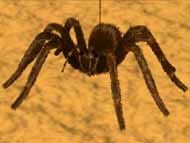The Story of Boris
Have you ever wondered about the origins of Delcam's spider logo?
Most of our readers are familiar with Delcam, a leading supplier of CAD/CAM solutions for manufacturing including PartMaker, FeatureCAM and PowerMill. The company’s product logos are easily recognizable as they incorporate a CAD-rendered spider named Boris. But what is the origin of this arachnidian model and how did it become a manufacturing software icon?
In 1984 Jon Hunwick joined Delcam (or Delta CAE, as it was known then) as technician to the DUCT Development Unit in Cambridge. After an initial training period learning how to do routine tasks such as making sure the PRIME 250 computer started up every morning and creating backup tapes (reel-to-reel!) of all the previous days’ work, he was approached one morning by David Sturge with a copy of the DUCT 4.2 manual and some brief training notes. David simply said, “Learn this.”
At about the same time, Gavin Miller (www.doctorgavin.com) joined the unit as a post-graduate student working on advanced ray-tracing. A massive Sigma frame-store was brought in to the department for Gavin to use, but it required huge amounts of processing power. Gavin found himself having to work overnight most of the time so he did not have to share computer time, instead, having the 250 all to himself.
As well as producing some interesting “mechanical” effects, lighting, shadows, reflections, and so on, Gavin was particularly interested in natural phenomena, such as rippling water, fractal landscapes and, especially, hair (being somewhat challenged in that department himself). After successfully creating the effect of fuzzy dice, Gavin was looking for a more interesting challenge, but what?
The answer came at about 2:30 one Tuesday morning. A large, and exceptionally hairy spider fell from the ceiling, landed on his keyboard, and then nonchalantly lowered itself to the floor before disappearing under the skirting board. As it progressed across the floor it grew bigger in Gavin’s mind until, to his imagination at least, it appeared the size of a small dog.
The next morning, when Jon arrived, Gavin asked him to make a spider in DUCT. “You can’t be serious,” Jon retorted.
“Yes, I can,” said Gavin. “It will be fun, and then I can render it all furry.”
About an hour later, Gavin disappeared into the town center and returned with a wooden toy spider. This was made of flat sheets of pre-cut plywood that could be slotted together to form a 3D model. Jon took all the individual pieces and traced them onto graph paper. During the next couple of days, the coordinates were transferred into DUCT, and slowly, Boris took shape.
Gavin then set to work and produced some spectacular images. But not satisfied with simply being able to create fancy pictures, another part of Gavin’s work was to create DUCT’s first multi-surface machining algorithms by using a technique called Z-buffering. Jon worked out how to machine and assemble the legs and pedipalps (antenna-like appendages) onto the main body, and the finished model was cut on the university’s Bridgeport Series 1 CNC milling machine.
About a month later, Jon took the metal Boris to an exhibition in London. Managing Director Hugh Humphreys visited the show for a day, immediately fell in love with Boris and decided to take him back to Birmingham to make him the company mascot.
Since then, Boris has become the official Delcam logo, and hundreds of metal versions, in differing scales, have been produced. He has also been seen in STL format, and some rapid prototyping machine vendors even issue an STL version with each new machine.
The only remaining question is where the name “Boris” came from. Well, the answer is very simple. About the same time that Boris was created, the rock band The Who released a song called “Boris the Spider.”
RELATED CONTENT
-
Why Using Pirated Software is Riskier Than Ever
Machine shops and manufacturers that use pirated software risk losing much more – both directly and indirectly.
-
CAD/CAM’s Role in How Machine Shop Benefits from its First Swiss-Type
This manufacturer of high-end RC cars leverages the capabilities of its CAD/CAM software to get the most out of its first Swiss-type lathe even when job batch sizes are relatively low.
-
Consider the Software Side of Cutting Tools
The intersection of the cutting tool and the workpiece it is applied to represents the very heart of subtractive metalworking. There is a significant amount of technology behind getting the cutting tool into the right place, at the right speed and the correct depth of cut. This article looks at some of the software technology that can optimize the performance of the cutting tool.







